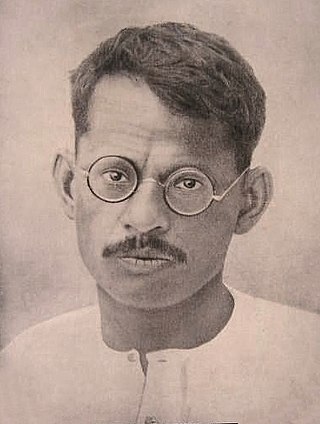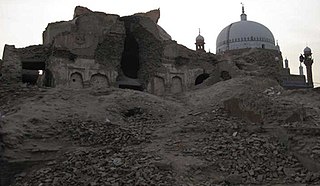Related Research Articles
The Chandni Chowk is one of the oldest and busiest markets in Old Delhi, India. It is located close to the Old Delhi Railway Station. The Red Fort monument is located at the eastern end of Chandni Chowk. It was built in the 17th century by the Mughal Emperor, Shah Jahan, and designed by his daughter, Jahanara. The market was once divided by canals to reflect moonlight. It remains one of India's largest wholesale markets.

Dhanpat Rai Srivastava, better known as Munshi Premchand based on his pen name Premchand, was an Indian writer famous for his modern Hindustani literature. Premchand was a pioneer of Hindi and Urdu social fiction. He was one of the first authors to write about caste hierarchies and the plights of women and labourers prevalent in the society of the late 1880s. He is one of the most celebrated writers of the Indian subcontinent, and is regarded as one of the foremost Hindi writers of the early twentieth century. His works include Godaan, Karmabhoomi, Gaban, Mansarovar, and Idgah. He published his first collection of five short stories in 1907 in a book called Soz-e-Watan.
Byculla is an area of South Mumbai.

Old Delhi is an area in the Central Delhi district of Delhi, India. It was founded as a walled city and officially named Shahjahanabad in 1648, when Shah Jahan decided to shift the Mughal capital from Agra. The construction of the city was completed in 1648, and it remained the capital of Mughal India until its fall in 1857, when the British Empire took over as paramount power in the Indian subcontinent.

Bithoor or Bithur is a town in Kanpur district, 23.4 kilometres (14.5 mi) by road north of the centre of Kanpur city, in Uttar Pradesh, India. Bithoor is situated on the right bank of the River Ganges, and is a centre of Hindu pilgrimage. Bithoor is also the centre for War of Independence of 1857 as Nana Sahib, a popular freedom fighter who was based there. The city is enlisted as a municipality of Kanpur metropolitan area.

Bangarmau is a tehsil and a municipal board in Unnao district in the state of Uttar Pradesh, India. It is located on high ground overlooking the left bank of the Kalyani river, about 50 km northwest of Unnao and 22 km northwest of Safipur. Roads fan out in all directions from Bangarmau, including the main Unnao-Hardoi road SH38 that passes through town. Major commodities produced here include wheat flour, rice, and pulses. As of 2011, the population of Bangarmau is 44,204, in 7,600 households.
Dibiyapur is a municipality-based city in Auraiya district in the most populous state of Uttar Pradesh in India. It is situated on State Highway 21. It is linked to Phaphund railway station on Kanpur–Delhi section of Howrah–Delhi main line and Howrah–Gaya–Delhi line which is operated by North Central Railway. The district administrative headquarter of the city is Auraiya. The city is situated between Agra and Kanpur. Lower Ganga Canal passes through mid of the city.
Sarila is a town, a former princely state and a nagar panchayat in Hamirpur district in the northern Indian state of Uttar Pradesh.

Ganesh Shankar Vidyarthi was an Indian journalist, a leader of the Indian National Congress and an independence movement activist. He was an important figure in the non-cooperation movement and the freedom movement of India, who once translated Victor Hugo's novel Ninety-Three, and is mostly known as the founder-editor of the Hindi language newspaper, Pratap.
Rath is a small town with a municipal board in Hamirpur district in the Indian state of Uttar Pradesh. Rath is a Tehsil of Hamirpur District. It is situated 506 km southeast of New Delhi.
Konch is a community development block of Gaya district in Bihar, India. Konch(Konch Village/Konch Panchayat/Konch Thana-Police Station) is a typical village market area slowly taking shape of a sub-urban settlement and centre of small business. Konch has very important temple known as Koncheswar Mahadev belonging to the later Gupta period which now has been taken under the protection of Archaeological Survey of India (ASI).
Ashok Nagar is a neighborhood in the city of Delhi. It constitutes a part of the Tilak Nagar assembly constituency as well as the West Delhi parliamentary constituency. The area was known as Tihar Village 2 before being renamed as such. It is an authorized neighborhood today, and the government of Delhi plays a role in its development.
Lalkurti, is a locality in the heart of Rawalpindi cantonment in Pakistan. Places with the same name are also found in many other garrison cities of Pakistan and India, such as Peshawar, Lahore, Kanpur, Ambala, Meerut and Delhi.

Prahladpuri Temple is a Hindu temple located in Multan city of Punjab province in Pakistan, adjacent to the Shrine of Bahauddin Zakariya. Named after Prahlada, it is dedicated to the Hindu deity Narasimha. In 1992, following the destruction of the Babri Mosque by Hindu extremists in India, the temple was razed to ruin in a retaliatory act of violence by a Muslim extremist mob. The site is currently owned by Evacuee Trust Property Board.
Palam is a major residential colony located in South West Delhi. It is one of 70 Vidhan Sabha constituencies of the Delhi National Capital Territory in northern India.
Daranagar is a town in Kaushambi, a suburb of Allahabad, in Uttar Pradesh, India. The town is located approximately 17 km to the north of the district headquarters of Manjhanpur and is known for the main Pilgrim Center and it is situated at the bank of the Ganga river. The main attraction in the town is the Daranagar Tirtha, dedicated to Bhagwan Shri Rishabhdev. In addition to these well-known monuments, there are many other temples, such as the Hanuman Temple, Jain Temple, Jwala Devi Temple, Ram Janaki Temple, and Kalbhairav Temple. Daranagar is known for the Shia Jama Masjid Syedwarah and the Sunni Shahi Jama Masjid built by Dara Shikoh, the son of the famous Mughal emperor Shah Jahan.
Naranga is a developing village and gram panchayat in Parihar, Sitamarhi district, Bihar, India.

The Ram Mandir is a partially constructed Hindu temple complex in Ayodhya, Uttar Pradesh, India. Many Hindus believe that it is located at the site of Ram Janmabhoomi, the mythical birthplace of Rama, a principal deity of Hinduism. The temple was inaugurated on 22 January 2024 after a prana pratishtha (consecration) ceremony. On the first day of its opening, following the consecration, the temple received a rush of over half a million visitors, and after a month, the average number of visitors was reported to be "1 to 1.5 lakh on a daily basis".

Balak Ram is the primary murti (idol) of the Ram Mandir, a Hindu temple built in Nagara style at the presumed location of Ram Janmabhoomi, the mythical birthplace of the Hindu deity Rama, at Ayodhya, Uttar Pradesh, India, to commemorate the birth of Rama. The location is loaded, and the building of the mandir is controversial due to the demolition of a mosque formerly located at the place, and is an important subject of political debate in India.
References
- ↑ "Why Brother TC is a very bad influence here... - Page 5 - Indians For Guns". indiansforguns.com. Retrieved 8 January 2017.
- ↑ Gupta, Shiv Prakash (1987). "Structural Dimensions of Poverty in India".
- ↑ "Muharram Mirror: Julus-E-Muhammadi(Kanpur)-Symbol of Victory Over British Regime". muharramheritage.blogspot.in. Retrieved 8 January 2017.
- ↑ Pandey, G. (2002). The Ascendancy of the Congress in Uttar Pradesh: Class, Community and Nation in Northern India, 1920-1940. Anthem Press. p. 113. ISBN 9781843310563 . Retrieved 8 January 2017.
- ↑ Joshi, C. (2003). Lost Worlds: Indian Labour and Its Forgotten Histories. Permanent Black. p. 262. ISBN 9788178240220 . Retrieved 8 January 2017.
- ↑ "Meston Road's date with I-Day continues". The Times of India. 15 August 2013. Retrieved 24 August 2018.
- ↑ Siddiqui, Faiz Rahman (15 August 2016). "Independence day celebrations began at 00:01 hrs in Kanpur". The Times of India. Retrieved 24 August 2018.
- ↑ "Tilak Hall renovated". The Times of India . Retrieved 8 January 2017.
- ↑ ""Cawnpore Kotwali" - Kanpur | police station". wikimapia.org. Retrieved 8 January 2017.
- ↑ Premchand: An Anthology. Bansal. 1981. Retrieved 8 January 2017.
- ↑ "Umbrellas, raincoats in demand". The Times of India . Retrieved 8 January 2017.